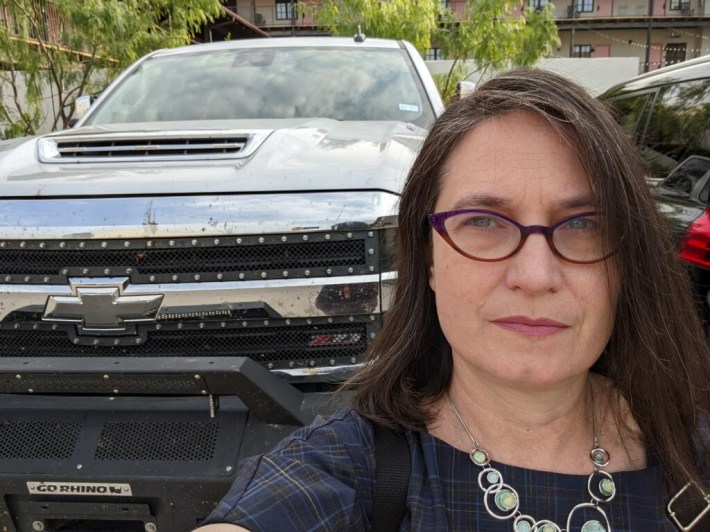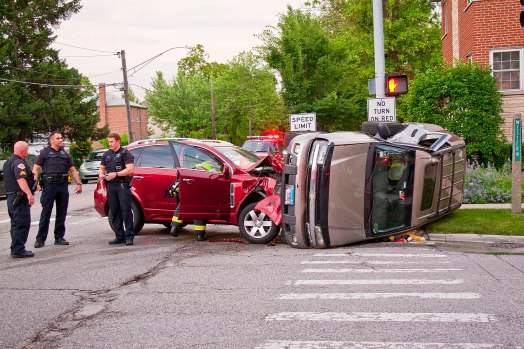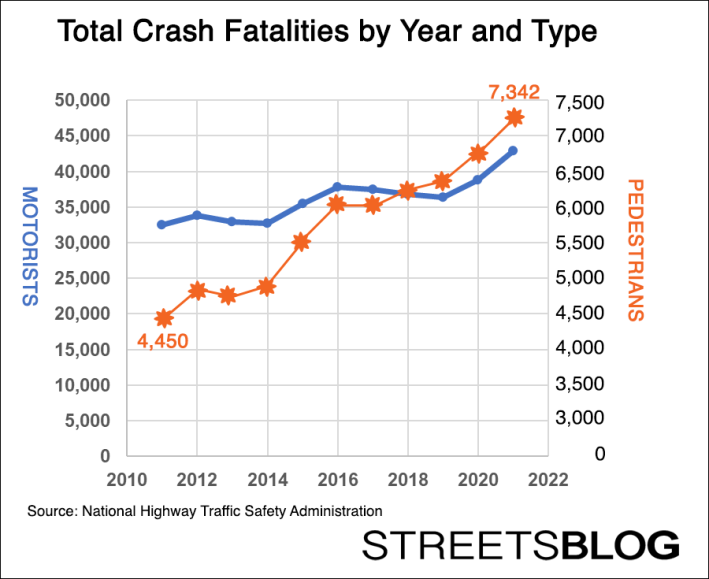Call it the forgotten pandemic: road fatalities surged by double-digit percentages, including a significant increase in deaths outside of cars, in 2021, according to a new report issued Tuesday by federal authorities.
According to the National Highway Traffic Safety Administration, 42,915 people died in motor vehicle crashes in 2021 – the most since 2005 and an average of 117 deaths every day. The death toll represents an increase of roughly 10.5 percent compared to 2020, but breaking down the numbers provide even more clarity about the carnage on American roads:
- Deaths on rural interstate roads were up 15 percent, on urban arterials were up 15 percent, and on urban collector/local roads were up up 20 percent.
- The share of fatalities on urban roads increased from 57 percent of deaths to 62 percent, a reminder that America's increasingly large vehicle fleet is out of step with urban spaces where a majority of Americans reside these days. Total fatalities on urban roads increased by 16 percent last year, from 21,940 in 2020 to 25,411 in 2021.
- Fatalities in the category of "speeding-related crashes" were up another 5 percent in 2021, which remains higher than the pre-pandemic levels of 2019.
- Deaths of people outside of America's increasingly large cars were also up significantly:
- Pedestrian fatalities were up 13 percent, from 6,516 in 2020 to 7,342 in 2021.
- Cyclist fatalities were up 5 percent, from 932 in 2020 to 985 in 2021.
Taken as a whole, advocates for road safety were horrified.
"We can never accept these deaths as simply the price of mobility and convenience," Russ Martin, Senior Director of Policy and Government Relations, Governors Highway Safety Association, said in a statement that reminded that "roadway deaths are preventable.""
"An increase in dangerous driving — speeding, distracted driving, drug- and alcohol-impaired driving, not buckling up – during the pandemic, combined with roads designed for speed instead of safety, has wiped out a decade and a half of progress in reducing traffic crashes, injuries and deaths," he added. "This grim milestone confirms we are moving backwards when it comes to safety on our roads."
Some advocates singled out drivers as the primary culprit and focus. For example, Advocates for Highway and Auto Safety issued a statement blaming "reckless driving, including speeding, impairment and lack of seat belt use" as "a major factor behind fatality increases that began during the early months of the COVID-19 pandemic."
The group said in the statement that it had "strong concerns that these behaviors would continue as traffic volumes increased from peak pandemic lows. These fears appear to be coming to fruition. The public is justifiably alarmed by these developments. ... Acting swiftly to advance solutions at both the federal and state levels to prevent crashes and save lives is the only acceptable response in the face of such overwhelming evidence and public distress."
But that focus has its own opponents.

"It is remarkable to me how the answer is always the same from some safety advocates: It's always those crazy drivers!" said Beth Osborne, the executive director Transportation for America. "But there are reckless people in other countries. Other countries have experienced the stress of the pandemic. Other countries have alcohol and people who drink too much. They also remarkably have smartphones and distraction. What they don't have are gigantic highways blasting through communities, encouraging dangerous speeds, even when people are going the speed limit. And they don't have cars with a front grill that blocks drivers' view of what's in front of them." (Osborne provided the selfie, above right, as an example.)
Meanwhile, the Governors Highway Safety Association doubled down on its recent demand for a "Safe System" approach to reducing road violence rather than merely relying on one element — driver education or enforcement — that has proven to be unreliable.
"We know the root causes of most traffic deaths and what we need to do to address them," Martin said. "The Safe System approach demands investment in a comprehensive range of countermeasures, including safer infrastructure, safer vehicles, public education and community engagement, equitable enforcement focused on the most dangerous driving behaviors, and post-crash care. All these elements are necessary to create a safety net to prevent or mitigate the impact of roadway crashes."
That's at least the thinking of the Biden Administration as well. Earlier this year, the U.S. DOT announced that, for the first time in history, it would commit to using every available resource to end roadway deaths and serious injuries on American roads — fully endorsing the Vision Zero concept embraced by many countries and even some American cities.
Back in January, Transportation Secretary Pete Buttigieg revealed the National Roadway Safety Strategy, which outlines the foundational principles the agency will follow to achieve zero road deaths, as well a slate of initial rule-making actions aimed at making every element of the transportation network safer. That strategy is deeply rooted in the “Safe System" approach,” which focuses on “safer people, safer roads, safer vehicles, safer speeds, and post-crash care” — a paradigm shift for which sustainable transportation advocates have fought for decades.
“Americans deserve to travel safely in their communities,” Buttigieg said in a statement at the time. “Humans make mistakes, and as good stewards of the transportation system, we should have in place the safeguards to prevent those mistakes from being fatal. Zero is the only acceptable number of deaths and serious injuries on our roadways.”
Following up on that, the U.S. DOT announced on Monday, a day before the fatalities report, that it had opened the application process for communities of all sizes to apply for grants to make roads safer and "address the national roadway safety crisis."
The Bipartisan Infrastructure Law that passed last year included $1 billion in such grants for Fiscal Year 2022.
Corinne Kisner, the executive director of the National Association of City Transportation Officials, heralded the grants.
“The most effective safety interventions are often small-scale investments deployed at scale, from building new sidewalks that connect to transit, to redesigning intersections, installing curb extensions, connecting gaps in bike lane networks, and raising crosswalks,” she said in a statement. “For the first time, federal transportation funding can be focused on these small interventions that make an enormous difference in people’s lives — and are often the difference between saving a life and counting another death on city streets.” (Previously, cities were basically "on the front lines" of progressive change, Kisner added.)
The report also showed that it's a bit of a myth that America's cars are getting safer for their occupants. According to the findings, fatalities of people inside cars rose 2 percent for drivers of cars older than 10 years and rose 10 percent for drivers of newer cars.







